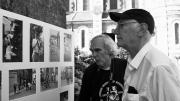In his sophomore year, William Christian ’65 received an unusual invitation. He had been taking a course, “How To Study A Village,” taught by Dillon professor of the civilization of France Laurence Wylie, an anthropologist and cultural historian who had been investigating Chanzeaux, a small town about 200 miles southwest of Paris. One day, Wylie announced: “I’m going to Chanzeaux to study the elections. Does anybody want to come along?”
Christian went, and along with other students became part of a long-standing relationship connecting Wylie, Harvard, and the village of Chanzeaux that survived Wylie’s death in 1995 and continues to this day. That relationship is the subject of a documentary scheduled for release in early 2012—Harvard at Chanzeaux: A Tribute to Laurence Wylie, by British filmmaker Elizabeth McKay and her colleagues Serge Aillery and Farid Reskallah. McKay says she was fascinated by Wylie’s interest in small French villages: “Why someone who was born in Indiana, the son of a Methodist preacher, should suddenly get to love France so much.”
Chanzeaux was the second French village Wylie studied. But unlike his research in Roussillon, the subject of his book Village in the Vaucluse, the project in Chanzeaux was a group effort. Not only did Wylie himself live in the village for a year with his two sons, he integrated a continual stream of visiting students into village life. It was their observations that would later form the core of the study Chanzeaux: A Village in Anjou, which professor and students wrote collaboratively.
Wylie’s students lived with local families, attended the parish church, and worked on farms. They were given great freedom. “He would get you a grant to go to Chanzeaux,” recalls Tom Yager ’64, who returned for the filmmaking, “but he never told you what to do.” That generous spirit marked many of Wylie’s interactions with his students and with the villagers. “He was totally different from any other teacher I have known. He shared things. He got us to collaborate,” Christian says.
Village life in the 1960s was very religious—there were two masses every Sunday—and many of the inhabitants had rarely strayed from home. In 1965, there were 150 farms and several small businesses that animated village life.
Today mass is held only once every three weeks, and few people attend. Large farms have replaced traditional agricultural methods with new technology and many of the village shops and cafés have closed. Yet many residents still retain a strong attachment to Wylie. The twenty-fifth anniversary of his project was marked by a reunion that included Wylie and a large group of students. When one student got married in nearby Angers, villagers attended the ceremony—for many, their first Protestant service. And families from Chanzeaux have visited their former guests in the States. “The fact that this group of Americans had come to the town encouraged them to think of the world in a wider way,” says McKay.
As a focus of her film, McKay organized a Journée Wylie in Chanzeaux in July, coinciding with Bastille Day. Several former students, including Christian and Yager, as well as Wylie’s sons, returned to witness the official opening of the “Salle Laurence Wylie” in the village presbytery. A small exhibit of old photos was set up, and many villagers came to reminisce about people from the past. The filming itself, Christian explains, “sometimes involved surprising us with footage; or taking us to places where we had worked, like a now-abandoned tobacco barn. It was moving that the townspeople had mobilized to recognize this unusual aspect of their past, and did so in a day of sweet and evocative events.”









